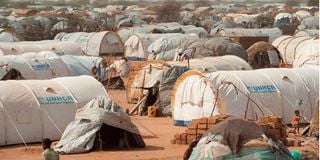Dadaab, Kakuma refugee camps to transition into integrated settlements

Aerial view of a section of Dadaab Refugee Camp.
The government will transition Dadaab and Kakuma refugee camps into integrated settlements in which refugees will co-exist with host communities.
In the arrangement, the refugees will benefit from government services as it kicks off the planned closure of the two camps over security concerns.
On Wednesday, an intergovernmental steering committee was launched to align the transition plan with the country’s national security priorities amongst them the Refugee Act (2021) that outlines the refugees and asylum seekers privileges, opportunities and occasions when such shall be withdrawn.
According to Interior Principal Secretary (PS) Raymond Omollo, other key priorities of the committee that will be coordinated by Interior CS Kithure Kindiki will include heightening border security and screening to prevent an influx of more refugees and enforcement of law and order in the settlement areas.
Kenya is currently the fifth largest refugee hosting country in Africa and the 13th largest asylum country in the world hosting an excess of 800,000 of both. Majority reside in the Dadaab and Kakuma refugee camps as over 91,000 others are hosted in other urban counties mainly Nairobi.
In 2021, the government announced a its decision to close Dadaab and Kakuma refugee camps, both of which at the time were hosting over 500,000 refugees mainly from the neighboring Somalia.
It said the camps had become avenues for arms and contrabands smuggling from Somalia and breeding grounds for terrorism where attacks have been planned against Kenyans by al shabaab militants.
Security officials further explained that Kenya had shed enough blood to stabilize Somalia and need not suffer terror attacks as a result of its hospitality.
This is after intelligence reports confirmed that the 2013 Westgate attack, 2015 Garissa University and 2019 Dusit Complex attacks were planned and executed from Dadaab noting that al shabaab continuously took advantage of the overcrowding, under-resourced conditions and limits to policing UN-run sites to enter the camps posing as refugees to operate with an alarming degree of freedom.
“Kenya has stood on the front-lines of challenging terrorism, upholding humanitarianism and pursuing global peace and security. We however, have no grounds to keep compromising the security of our citizens in the face of foot-dragging, double-standards and lack of commitment in the rapid settlement of Somali refugees in their homeland,” former Interior PS Karanja Kibicho said.
Consequently, PS Omollo cautioned that the settlement plan needs to be carried out carefully so that it does not become a magnet for criminals seeking avenues to sneak into the country.
“We need to be sensitive in ensuring that the design and implementation of this plan does not become a pull factor of asylum seekers and refugees within the region. As it is today we are having asylum seekers in Trans nzoia, these are largely individuals who are coming from the DRC, Uganda and Tanzania and the numbers are rising. Ordinarily that place is supposed to be a transit point with a capacity of just around 400 but we are already seeing numbers in excess of 1,000,” the PS said during a stakeholders meeting on the settlement plan in Nairobi.
According to the Refugee Act, all registered refugees will enjoy a right to civil registration and identification that is sufficient to identify them as refugees or asylum seekers.
“The current refugee population in Kenya is close to 800,000, over 577,000 are registered and over 200,000 are being profiled in either Dadaab or Kakuma refugee camps. Majority of these refugees are asylum seekers from the Great Lakes and the Horn of Africa Regions,” said Immigration and Citizen Services PS Prof Julius Bitok.
They shall also access permits to enable them engage in gainful enterprise whether as individuals or in groups and shall be eligible for employment hence playing part in the economic development of their host communities.
Those that later opt to return to their native countries will be at liberty to do so after surrendering the documents issued to them by the government.
The move shall also change the funding model of refugees from aid dependency to development and self-reliance as county governments hosting refugees transform the areas where refugees are concentrated into municipalities making them eligible for support by development partners such as the World Bank and the UN Habitat.
Turkana County has already elevated Kakuma town into a municipality with Garissa governor Nathif Jama Adam confirming that he shall soon sign off the charter that elevates Dadaab town into a municipality.
This will attract investors to set up permanent structures that will gradually face off the makeshift tents as refugees upgrade their lifestyles from their earnings.
UN agencies, Donor partners and NGOs working in the two camps pledged their support to the plan terming it sustainable and able to ease pressure for the resources in the host communities.
The privileges will however be withdrawn for them that engage in criminal activities especially war crimes and crimes against humanity.





